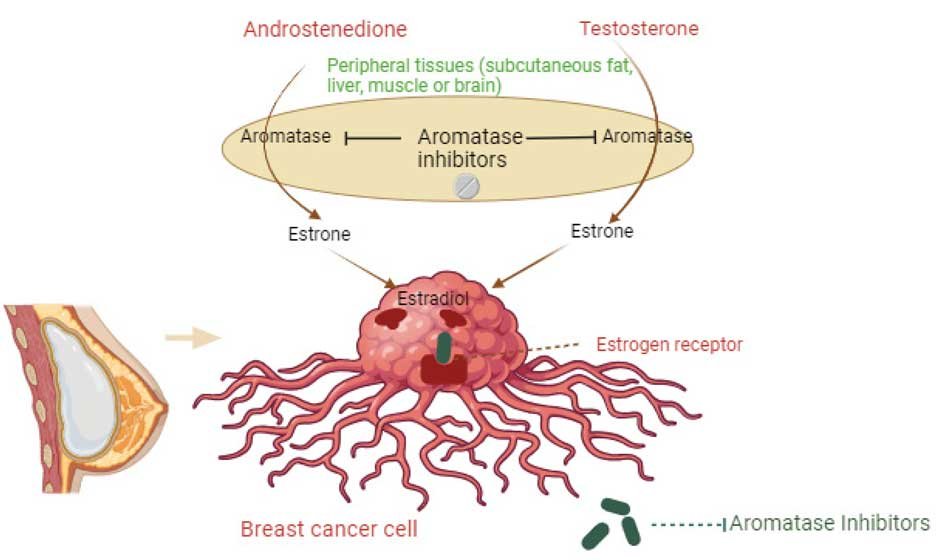Estrogen, a hormone central to the development and function of reproductive tissues, can also play a pivotal role in certain types of breast cancer. The complex relationship between estrogen and breast cancer has steered a significant portion of treatment research toward understanding and mitigating the hormone’s impact on tumor growth. Estrogen inhibitors are fundamental in the fight against hormone receptor-positive breast cancers and changes the way these cancers are treated. Below, we delve into the role of Estrogen inhibitors in breast cancer treatment.
Understanding Estrogen’s Role in Breast Cancer Development
Estrogen promotes the growth of cells in the breast, a normal process that can go awry when cells become cancerous. Breast cancer cells that are hormone receptor-positive thrive on estrogen, which fuels their proliferation and survival. This connection is observed in up to 70% of breast cancer cases, where the presence of receptors is a critical factor in the behavior of the disease.
Deciphering this relationship was pivotal in the advancement of targeted therapies. Research has demonstrated that by interrupting the estrogen signaling pathways, it is possible to blunt the disease’s progression. This discovery has led to the development of various pharmaceutical strategies to lessen the hormone’s impact on breast cancer.
Not all breast cancers are sensitive to estrogen. But for those that are, hormone therapy has become an essential part of treatment. These therapies are especially beneficial for early-stage cancers and as adjuvant treatments, helping to reduce the risk of cancer recurrence after primary treatments like surgery or chemotherapy.
Exploring the Mechanism of Estrogen Inhibitors in Cancer Therapy
Estrogen inhibitors, or blockers, function by preventing estrogen from supporting the growth of cancer cells. These drugs can either lower the amount of estrogen in the body or block its action at the receptor level. This not only halts the growth of existing cancer cells but also seeks to prevent the development of new cancerous growths that rely on estrogen.
There are primarily two classes of inhibitors: aromatase inhibitors and selective estrogen receptor modulators (SERMs). Aromatase inhibitors work by suppressing the enzyme aromatase, which converts androgens into estrogen, thus reducing the overall level of estrogen in the body. SERMs, on the other hand, bind to receptors, preventing estrogen from docking and signaling the cells to grow.
Beyond these, a newer class of drugs called selective estrogen receptor degraders (SERDs) has emerged. SERDs not only block estrogen receptors but also contribute to their degradation, reducing the total number of available receptors for estrogen to bind. This multi-faceted approach further strengthens the blockade against cancer cell growth.
Comparing Types of Inhibitors Used in Clinical Practice
Within the category of inhibitors, various drugs offer different approaches to management. Tamoxifen, one of the most commonly prescribed SERMs, has been used for decades in the treatment of hormone receptor-positive breast cancer. Its efficacy in both premenopausal and postmenopausal women has seen it become a mainstay of cancer therapy.
Aromatase inhibitors, including anastrozole, letrozole, and exemestane, are predominantly used in postmenopausal women. These drugs aim to starve the cancer cells of the hormone they need for growth. Each of these inhibitors has unique properties that may be better suited to certain patients over others.
In recent years, fulvestrant, a SERD, has gained attention for its robust anti-estrogen activity. Its use is particularly valuable in cases where the cancer has progressed despite treatment with other inhibitors. This highlights the ongoing evolution of cancer therapy as new and more effective treatment options become available.
Overall, the strategic application of inhibitors in the management of breast cancer denotes a promising direction in cancer care. As research progresses, physicians continue to refine their use, aiming for maximal impact on survival rates while mitigating the toll on patients’ daily lives. The ongoing collaboration between researchers, clinicians, and patients is paving the way for a future where breast cancer is not just survivable, but where quality of life during and after treatment remains a priority.
















